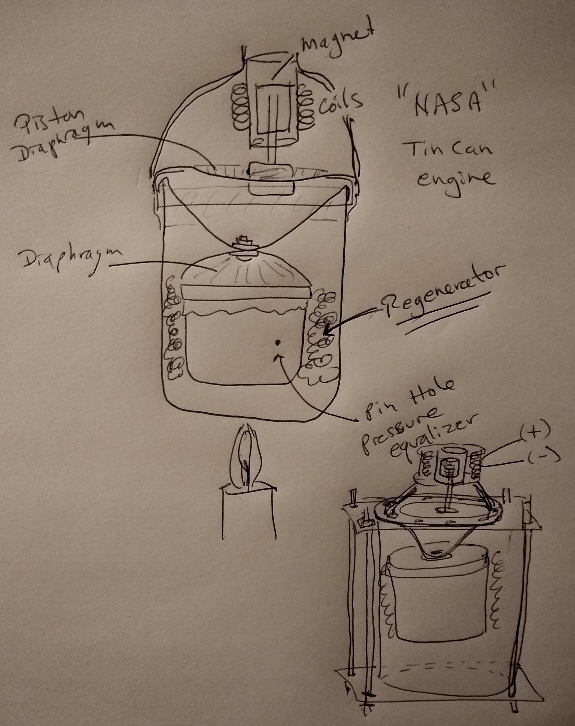Well, in that engine, the steel wool is the regenerator, I think, but it is part of the displacer, that, in spite of the pressure equalizer pinhole, probably does create a change in internal volume, as air, likely does not pass through the pinhole in enough volume to actually allow any appreciable amount of air through in a cycle.
So the whole regenerator/displacer assembly might in fact be doing what I had in mind. But it is difficult to know for certain without being able to see inside and watch the action, inside in low motion.
So, what I think I will do is build a transparent version.
While I'm at it, I still have some shake flashlights with linear generators and want to try mounting the works of one of those on top of the engine to generate some power and see what the output might be. If it could charge a cell phone I'd be excited.
Regardless of the "elastic regenerator" question, I'm very glad that you posted that video. I'm always glad to to see an engine that is easy to put together, yet seems to have some potential for power production.
I sketched out some construction plans, mostly just to get it clear how this engine is put together. I need to watch the video again, or a few more times.

- Resize_20220215_225301_1927.jpg (284.32 KiB) Viewed 1399 times
My sketch shows the generator on top as well.
At the lower right is the glass version, using a cylindrical glass candle holder. Basically a glass cylinder open at both ends.
I have an old digital camera that is capable of a decent frame rate. I want to see the motion of the displacer/regenerator in relation to the power diaphragm.
I assume what goes on is pushing the power diaphragm down to get the engine started creates higher pressure.
Inside the displacer is then comparatively lower pressure so the balloon on the displacer is sucked into the displacer can, lifting the displacer which displaces air to the bottom which heats that air which expanding air drives the power diaphragm up and increases the pressure.
No, that can't be right. Higher pressure would cause the displacer to go up more.
OK so it does, the piston continues up also.
Eventually the heat is used up and the gas cools, the pressure drops, the displacer diaphragm expands, the displacer drops, heat is absorbed by the steel wool, the power piston is drawn down.
Anyway, what I had in mind for an "elastic regenerator" was the steel wool (in a different form) could be made of Nitinol, expanding and contracting as hot and cold air passed back and forth through it, the Nitinol could be "trained" to change shape in a way that would drive an internal "air spring" type piston altering the internal pressure in a way that would augment the expansion and contraction of the gas, adding power to the engine.
But, this looks like it very well may be a simpler way to produce the same kind of of effect, but in a different, much simpler way.
Again, thank you for bringing my attention to this engine. I think I may work on building a transparent version right away, as I have all the materials on hand already and it shouldn't take a lot of time, so no excuse not to really.